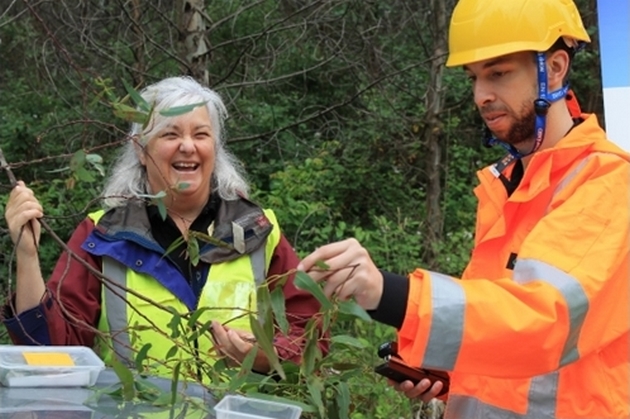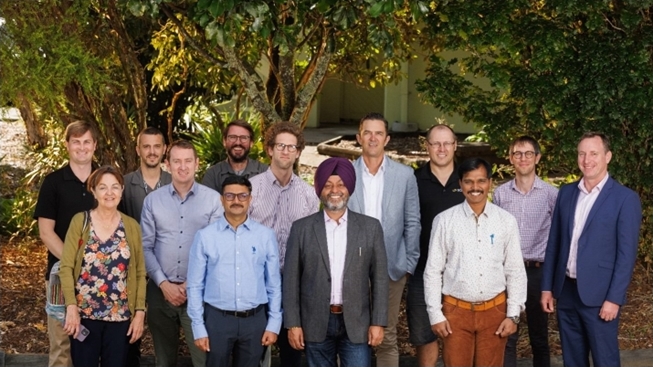Forest Health News No. 313 - April 2023
Revenge against Paropsis - Eadya daenerys is in the field
The eucalyptus tortoise beetle (Paropsis charybdis) remains one of the most serious insect pests in New Zealand causing defoliation of several eucalyptus species in the Symphyomyrtus subgenus - in particular, the fast growing, short fibre species Eucalyptus nitens. The cumulative effect of growing tips being removed by the adult beetles as well as the young larvae feeding on the flush, has a significant impact upon tree form, height, and stem volume potential of the tree.
Scion scientists have unleashed a torrent of revenge upon this pest, with the latest biological control agent Eadya daenerys (a Braconid wasp) first released in December 2022. This achievement has taken nearly ten years, spanned three separate MPI and industry-funded Sustainable Food and Fibre Futures grants, and overcome numerous scientific hurdles, such as the parasitoid being infected with a microsporidian from its home in Tasmania. The biocontrol agent is much more challenging to rear than the pest it attacks. A small number of adult female wasps, and over 10,000 eucalyptus tortoise beetle larvae with the parasitoids living inside their bodies, were released in December 2022 and January this year. The release locations, one in Central North Island and two in Southland, were chosen by our commercial co-funding partners Southwood Exports Ltd and Oji Fibre Solutions Ltd. There were strict criteria for selecting the suitable planted forests, including not having been sprayed for the previous two years, having sufficient populations of the pest in the planted forest, but not so many that they had already removed all the flush foliage.
Everyone in the project team hopes the parasitoid will establish here in New Zealand and make a population impact on this pest. If additional funds can be secured, Scion scientists will undertake additional releases as well as monitor for success over the next two summers. The goal of this project is to achieve control with fewer aerial pesticide applications to Eucalyptus nitens planted forests being required. Reducing spray frequency will have many environmental benefits that will ensure planted forests can be home to numerous beneficial organisms, including bees and ladybirds, as well as have healthy waterways. Approximately three quarters of all the attempted forestry pest biocontrol projects in New Zealand have succeeded in establishing a natural enemy to provide biocontrol. Other examples of successful biological control projects in forestry include the blue gum psyllid, sirex wood wasp, the eucalyptus snout weevil and the gum leaf skeletoniser. Scion hopes Eadya daenerys will add to this winning record.
Toni Withers, Scion

Indian officials visit Scion
Recently, Scion hosted delegates from the Indian Department of Agriculture and Farmers Welfare, MPI officials, and industry representatives as a part of a visit around market access for multiple primary sectors. The Indian delegation were considering ways to resume regular exports of logs from New Zealand to India – currently these exports have been stopped.
Scion scientist, Nicolas Meurisse, has been researching Sirex noctillio (the woodwasp) – the main pest of concern in India. Nicolas and other researchers presented to the group an overview of New Zealand’s forestry system, biosecurity surveillance and outlined pest and disease status for export logs. Discussions around methyl bromide and other fumigants used in New Zealand were held and the group took a tour of Scion’s Forest Health laboratory where Scion researchers showcased our expertise in forestry insects and pathogens.
The woodwasp is an invasive species and feeds on trees, acting as a vector for a fungus that kills pine trees. However, it is no longer considered a serious threat to New Zealand pine plantations because biological controls and stand management practices have enabled a significant reduction of its population.
MPI considers that the likelihood of Sirex from entering, establishing, and spreading in India from New Zealand’s export logs with a phytosanitary treatment is negligible. Effective phytosanitary treatments and silviculture practices covering a range of processes have been used to control or eradicate pests or contaminants of plants for export.
Recently, the Environment Protection Authority (EPA) decided to ban the use of ozone depletory, methyl bromide, in ship holds for Pinus radiata logs. Using methyl bromide to fumigate logs in ship holds is the only commercially viable option of shipping logs to India.
Scion was one stop among other destinations around the country; the Indian delegation also visited the Port of Tauranga, MPIs Auckland office, and the insect breeding programme at Plant and Food Research in Mt Albert, Auckland.

Summer students roundup
Olivia Mairs
My experience at Scion this summer has been incredible. Working alongside leading experts in different areas has widened my understanding of what everyday life could be as a scientist. I have been involved in field work, where I got to see beautiful native forests and set canopy Flight Intercept Traps (FIT), ground FIT and pitfall traps to sample insect abundance and diversity through different sites. I also got to do lab work where I used a microscope, sorted, identified, and pinned insects with guidance, and used the insect collection to compare species of taxa we collected. Something I enjoyed the most, which also challenged me, was seeing the vast array of insects we have in New Zealand and trying to sort and identify them to family, species and even genus. These ranged from barely visible to the naked eye to 10 cm in size which was amazing to see and gain experience with.
Elizabeth Steel
I worked on the Active Surveillance project, which aims to use an insect’s ability to sense pheromones and host plant volatiles to detect other members of its species. By monitoring the electrical signal that gets sent from the insect antennae to the brain, we can detect the insect responding to stimuli and use this to track down other insects. I produced a proof-of-concept computer code that would automatically identify these electrical responses, convert the data into a machine learning-compatible format, and make summary graphs and statistics to give a holistic view of the data. I really enjoyed the practical experience this project gave me – while working with real-life data can be a challenge, it developed my coding and problem-solving skills. I was also exposed to areas of science I wasn’t familiar with, such as insect trapping trials. I’ve never done much work in forests before this summer, so getting these new experiences was a very cool opportunity.
Amanda Lodge
The project I have been working on is the mass rearing of Eucalyptus tortoise beetles (Paropsis charybdis) for the introduction of Eadya daenerys as a biocontrol agent. Mass quantities of the pest beetle were reared in the lab as hosts of the Eadya parasitoid wasp for release in the field. The process included using the mated female wasps to sting the beetle larvae and feeding them until they were ready to be released, which was great to be a part of.
While working at Scion I have felt like a valued member of the project and gained hands on experience in each step of the project, from egg collection right through to the release of the Eadya. I enjoyed going out into the field to complete assessments and parasitoid releases and I am interested to see the long-term results
I have learnt many things, including how important it is to complete thorough field assessments and how to distinguish the beetle’s different egg parasitoids in samples collected. Working with parasitoid wasps and invasive beetles has sparked an interest in the biological control of pests and I have discovered just how fascinating insects are!
Billy Forrest
I’ve been lucky enough to be a part of Toni Withers’ Eadya parasitoid rearing project this summer. I grew up in Rotorua for 18 years then left for Auckland to study Environmental Science, but coming back to stay in the summer had me jumping at this opportunity. I’ve always known of Scion, and I was itching to do something within the field of which I study, and it was a bonus to get me out of doing retail for another year.
The overarching goal of this project is to introduce an environmentally friendly biological control for the leaf-eating Paropsis beetle that devastates Eucalyptus trees. My job was to care for and breed the Eadya wasps for the purpose of release into the designated sites. People usually freak out when they hear the word wasps, but these aren’t like the invasive German wasps. Eadya are originally from Tasmania and do not form colonies or sting people.
Through this entire process I really picked up a lot; getting first-hand experience into the inner workings on scientific research. Overall, I found this experience insightful. As an undergraduate at university, there is limited opportunity to do research, but being in the space with real scientists and dealing with real challenges was something I found invaluable. It was great to be a part of a supportive team environment; I felt like an integral part of this project and I am grateful to be included and I will take this experience with me.
Frances James
This was my third summer working on the Paropsis charybdis biological control research project. The project this year was the most demanding so far because of the number of beetles that we had to rear and the amount of parasitising of larvae that needed to be done. Probably the most challenging aspect of my role this year was trying to count, under a microscope, exactly how many tiny parasitoid eggs are left behind in the abdomens of the Eadya wasps when they die. Having worked on this project over the years in preparation for the release of the parasitoid, it was very rewarding to see the hard work paying off. I look forward to hearing about the success of Eadya in the future.
Newsletter of the Scion Ecology and Environment team. Edited by Andrew Pugh and Darryl Herron, Scion. Contact: Andrew Pugh
